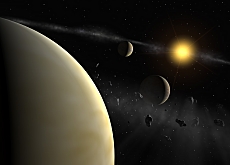
Discovery could help in hunt for alien life

A Swiss-led team of scientists has detected a new planetary system, consisting of three planets, outside our solar system.
The findings, which researchers say could help in the hunt for planets that support life, were published on Thursday in the science journal Nature.
“This discovery is an important step in our quest for a similar solar system to our own,” Michel Mayor, professor of astronomy at Geneva University, told swissinfo.
The “unusual” new planetary system, 40 light years away in the Puppis constellation, comprises three small planets – two thought to be of rocky formation – which are approximately ten to 18 times the mass of the Earth.
They revolve around the same star, which is slightly smaller than the Sun and just visible with the naked eye, and an asteroid belt, similar to the one between Mars and Jupiter.
Rough planets
“The two rocky planets might be heavier than the Earth, but there are lots of elements to suggest similarities with our solar system,” Mayor said.
Most of the 180 planets that have been discovered outside the solar system over the past ten years are much heavier than the Earth, and of gaseous composition.
Mayer believes that the new discoveries could help scientists understand how planets are formed.
“No doubt it will help us better comprehend the huge diversity we have observed since the first extra-solar planet was found 11 years ago.”
Today a majority of scientists believe that planets are formed out of disks of space dust and gases that rotate around young stars. The discovery of this new planetary system reinforces this theory, said Mayor.
For over two years the European team of astronomers has been carefully studying the new system, known as HD 69830, or Neptune’s Trident. The three planets are estimated to have roughly the same mass as Neptune.
Phone home
Another aim of the research was to find planets that could potentially support extraterrestrial life.
“We want to find similarities with Earth so that in ten to 15 years people can pinpoint planets that can then be better researched,” Mayor said.
“Many people believe that life is supported more favourably on smaller rocky planets with water and a suitable atmosphere.”
This new discovery was made possible by the Higher Accuracy Radial Velocity Planet Searcher (HARPS), an instrument on the 3.6-metre telescope at the European Southern Observatory at La Silla in Chile.
“HARPS is presently the world’s most precise planet-hunting machine,” said Mayor. “By improving our instruments we are gradually able to detect large Earth-like planets.”
swissinfo, Simon Bradley
The team is made up of 14 astronomers from eight European research institutions.
From Switzerland are Michel Mayor and Christophe Lovis from Geneva University and Willy Benz and Yann Alibert from Bern University.
Michel Mayor and Didier Queloz were the first astronomers to discover an extra-solar planet – a planet outside our solar system – in 1995.
As of 2006, over 180 of these so-called exoplanets have been discovered.
The three new planets have a mass range roughly that of Neptune – 10, 12 and 18 times the mass of the Earth.
They are 40 light years away in the Puppis constellation. By contrast, it takes 8.3 minutes for light to travel from the Sun to the Earth.

In compliance with the JTI standards
More: SWI swissinfo.ch certified by the Journalism Trust Initiative






























You can find an overview of ongoing debates with our journalists here . Please join us!
If you want to start a conversation about a topic raised in this article or want to report factual errors, email us at english@swissinfo.ch.